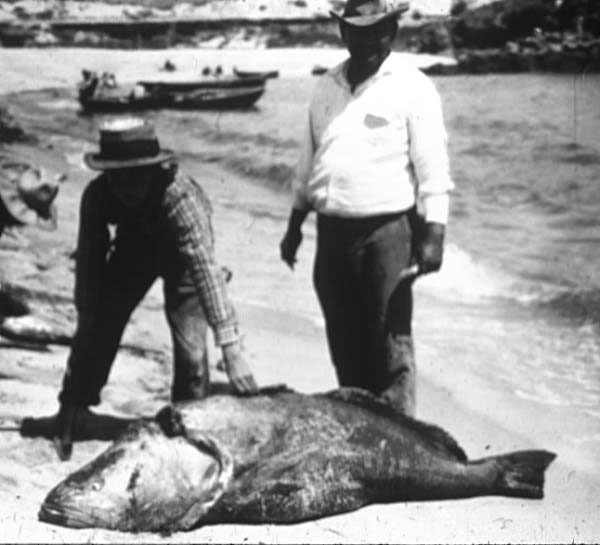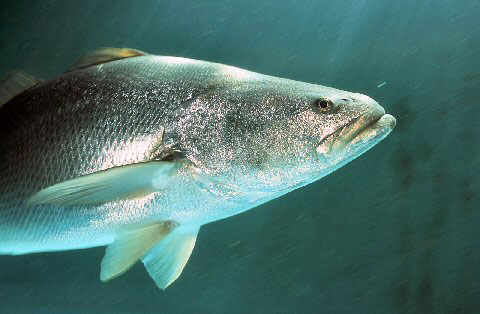Mexico’s Sea of Cortez is known for it’s large and diverse population of sea life. Its unique and rich ecosystem is known for many migratory species, such as humpback whales, the California gray whale, killer whales, manta rays, Humboldt squid, and the world’s largest animal – the blue whale. With more than 900 islands provide nesting and breeding sites for millions of sea birds, and a maximum depth of nearly 10,000 feet, the sea is likely home to many species we have yet to discover.
In addition to its more well-known sea life, the Sea of Cortez is also home to many which are endangered. One of those is the totoaba.
The totoaba (Totoaba macdonaldi) is a larger fish that can grow to 6+ feet long and weigh over 200 pounds. Its body is characterized by an elongated body, sharp snout with a large oblique mouth and a projecting lower jaw. The Totoaba’s gill covers have smooth edges and its fins are typically darker than their body, with a deeply notched dorsal fin. It’s also the largest member of the Scianidae or Croaker family of fish, so named due to the sound they can make with their resonating swim bladders.
Schools of adult totoaba migrate northward in the winter along the east coast of the Gulf of California to the Colorado River delta and remain there for weeks before spawning in the spring. Adults then migrate back south along the west coast for the rest of the year. Juveniles remain in the upper Gulf of California for two years before beginning this migration pattern. They begin reproducing after another 4 years for females and 5 years for males. It is believed that they can live up to 25 years.
Despite it’s size and once healthy population, the totuaba is one species which has suffered tremendously in the past 100 years, and due in part to the small area of the world which it calls home, the totuaba is now nearing extinction.

This huge totoaba photographed on the beach at San Felipe, Baja California in April, 1926, weighed 132 pounds after head and tail had been removed.
The end of the Colorado River
In its natural state, the Colorado River poured about 16.3 million acre feet of fresh water into the Gulf of California each year, amounting to an average flow rate of 22,500 cubic feet per second. Following the construction of the Hoover Dam in 1928, the reduction of fresh water flowing into the Gulf was significantly reduced or halted altogether.
Along with the reduced flow, both the water temperature and salinity has increased in the area where the river meets the sea – the area critical for the totuaba’s nursery and spawning habitat. The flow of fresh water to the mouth of the Colorado since the completion of the Hoover and Glen Canyon dams is now about 4% of the flow during the early 1900’s, and the salinity in the delta is now 35ppm or higher. This is one major cause of the depletion of the totoaba population. Since 1963, the only times the river has ever flowed any significant amounts of fresh water into the ocean have been during En Niño events in the 1980’s and 1990s.
Commercial Fishing
Commercial fishing has also taken its toll on the totoaba. In 1924, the commercial fishery began and at its peak in 1946, nearly 3 million pounds of totuaba filets were exported to the United States. In 1957 gill nets and dynamite fishing continued to devastate the populations. With improved fishing methods and an increase in demand, natural populations were severely reduced, and the catch decreased from 2,000 metric tons (4,409,245 lbs) in 1942 down to about 300 metric tons (661,382 pounds) in 1958, then down to 58 metric tons (127,870 lbs) in 1975. At that time, the fishery was closed completely and a preserve zone was designated at the mouth of the Colorado River.
In 1976, the totoaba was listed on the International Convention on Trade in Endangered Species of Fauna and Flora (CITES), in 1979 is was listed as endangered under the Endangered Species Act, and in 1986, it was listed as endangered on the IUCN Red List. Fishing, spearfishing, and taking of the totoaba are strictly prohibited.
The totoaba’s greatest, and final threat
Even with the drastic reduction in fresh water flow from the Colorado River and decades of heavy fishing pressure, the totoaba have managed to survive, although in much smaller populations. Now the totoaba are facing an even greater threat, and one which will likely result in their extinction: poachers.
Poachers of wildlife typically poach for one of several reasons: purely for the sport of spearfishing, some because the flesh is particularly tasteful, and others to profit monetarily. Financial profit is exactly what’s driving the current poaching of the totoaba – and the strongest demand, and the money, is coming from a place more than 8,000 miles away – China.
Totoaba closely resembles another fish that was highly desired in the Asian community and pretty much fished to extinction. It’s believed that Mexicali’s large Chinese population may have helped identify the similar totoaba fish as a delicacy option and developed a trade for it. The most prized part of the totoaba isn’t the flesh however – it’s a small organ that helps the fish maintain buoyancy in the water. The swim bladder.
Although the totoaba can grow to 6 feel long and 200 pounds, there is only one small part of the fish that poachers are after – the swim bladder. Weighing mere ounces, the swim bladder is an internal gas-filled organ that contributes to the ability of the totoaba to control its buoyancy, and thus to stay at the current water depth without having to waste energy in swimming. They’re found in virtually all ray-finned fish.
In the Chinese culture, the fish swim bladder is referred to as “fish maw” and may also come from a variety of non-endangered fish. Totoaba fish maw is highly valued for its high collagen content and some people believe the totoaba swim bladders can boost fertility and improve circulation and skin vitality.
Due to the demand and extremely limited supply of totoaba swim bladders, they’re also worth a ton of money. One bladder from the totoaba can garner well over $10,000 in Asia ( An investigation by the online news site Mexicali Digital revealed that the bladders can fetch anywhere from $7,000 to $14,000 a piece in the black market.). Once landed, the fish are simply stripped of their bladders and left on the beach, meat and all, since the traders don’t care about the meat. Being caught with it would also be a liability.
In one recent case, a U.S. Customs and Border Protection officer inspecting a car at the Calexico-Mexicali port of entry, about 130 miles east of San Diego, found 27 totoaba bladders hidden under floor mats in the back seat of a car. In another Jason Xie, 49, of Sacramento was accused of taking delivery of 169 bladders on March 30 in a hotel parking lot in Calexico, about 120 miles east of San Diego. Xie told investigators he was paid $1,500 to $1,800 for each of 100. Needless to say, for every large bust, hundreds and maybe thousands of poachers successful sell their catch without being caught.
Smuggling penalties for killing the endangered totoaba include maximum penalties of up to 20 years in custody, $250,000 in fines and supervised release up to three years. Because the profit potential is so high, it’s worth the risk to many poachers and smugglers. And with all the money involved, a high level of corruption also abounds.
__________________________________________
Further information and research:
• Feds charge 7 in probe targeting smuggling of highly prized fish bladders
• Made in the American West, consumed in China
• 7 charged with smuggling fish bladders to China
__________________________________________



